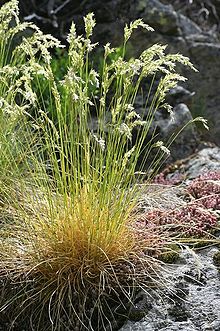Festuca eskia
| Festuca eskia | |
|---|---|

| |
| Scientific classification | |
| Kingdom: | Plantae |
| Clade: | Tracheophytes |
| Clade: | Angiosperms |
| Clade: | Monocots |
| Clade: | Commelinids |
| Order: | Poales |
| Family: | Poaceae |
| Subfamily: | Pooideae |
| Genus: | Festuca |
| Species: | F. eskia
|
| Binomial name | |
| Festuca eskia Ramond ex DC.
| |
| Synonyms[1] | |
| |
Festuca eskia is a species of grass which is endemic to southwestern Europe.[2]
Description
The plant is perennial and has caespitose with 22–50 centimetres (8.7–19.7 in) long culms and 1–2.2 millimetres (0.039–0.087 in) wide. The ligule is 3–7 millimetres (0.12–0.28 in) long and is going around the eciliate membrane. Leaf sheaths are smooth and have a hairy surface while the leaf-blades are straight but curved and are 0.7–1.6 centimetres (0.28–0.63 in) broad. The panicle is contracted, linear, inflorescenced and 9.5 centimetres (3.7 in) long with branches being as hairy as leaf-sheaths. The same is with leaf-blades, only they are also ribbed and have a pungent apex.[2]
It hybrizes with F. gautieri giving rise to the natural hybrid, F. xpicoeuropeana.[3]
References
- ^ The Plant List: A Working List of All Plant Species, retrieved 26 July 2017
- ^ a b W.D. Clayton; M. Vorontsova; K.T. Harman; H. Williamson (November 16, 2012). "Festuca eskia". The Board of Trustees, Royal Botanic Gardens. Kew: GrassBase. Retrieved December 5, 2013.
- ^ Marques, I.; Draper, D.; López-Herranz, M. L.; Garnatje, T.; Segarra-Moragues, J. G.; Catalán, P. (2016-11-03). "Past climate changes facilitated homoploid speciation in three mountain spiny fescues (Festuca, Poaceae)". Scientific Reports. 6 (1): 36283. doi:10.1038/srep36283. ISSN 2045-2322. PMC 5093761. PMID 27808118.
